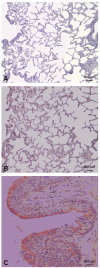Characterization of endothelin receptors in the peripheral lung tissues of horses unaffected and affected with recurrent airway obstruction
- PMID: 18783023
- PMCID: PMC2442677
Characterization of endothelin receptors in the peripheral lung tissues of horses unaffected and affected with recurrent airway obstruction
Abstract
The purpose of the study was to determine and compare the expression of endothelin (ET) receptors in the peripheral lungs of healthy horses and those affected with recurrent airway obstruction (RAO) using reverse transcriptase polymerase chain reaction (RT-PCR), real-time PCR, Western blot analysis, and immunohistochemical techniques. Two groups of horses (7 healthy and 7 RAO-affected) were selected from a pool of horses destined for euthanasia. The grouping of horses was based on the history, clinical scoring, and pulmonary function testing. After euthanasia, gross postmortem evaluation of the lungs was conducted, and lung samples were collected and either stored at -80 degrees C or fixed in zinc-formalin for 12 h. The RT-PCR was performed by using specific primers for ETA and ETB receptors, and beta-actin. To determine the relative gene expression real-time PCR was performed. To detect ET receptor protein expression, Western blotting and immunohistochemical studies were performed using polyclonal antibodies against ETA and ETB receptors and beta-actin. The ET receptor expression was determined by performing either densitometric analyses or scoring of immunostaining. Statistical analyses were performed to detect differences in receptor expression within and between the 2 groups. The results indicated that ET receptor expression, particularly ETB receptors, was significantly greater in the peripheral lungs of RAO-affected horses than in those of healthy horses. Clinical trials using ET receptor antagonists, particularly ETB antagonists might help in developing a therapeutic strategy to treat this career-ending disease.
L’objectif de la présente étude était de déterminer et comparer l’expression des récepteurs de l’endothéline (ET) dans les poumons périphériques de chevaux en santé et de chevaux souffrant d’obstruction récurrente des voies respiratoires (RAO) par réaction d’amplification en chaîne par la polymérase à l’aide de la transcriptase réverse (RT-PCR), par PCR en temps réel, par réaction d’immunobuvardage et par techniques immunohistochimiques. Deux groupes de chevaux (7 en santé et 7 atteints de RAO) ont été sélectionnés à partir d’un regroupement de chevaux destinés à l’euthanasie. Le groupement des chevaux s’est fait sur la base de l’anamnèse, le pointage clinique, et un test de fonction respiratoire. Après l’euthanasie, une évaluation des lésions macroscopiques des poumons a été faite, et des échantillons de poumons prélevés et soit entreposés à −80 °C ou fixé pendant 12 h dans une solution de zinc-formaline. L’épreuve de RT-PCR a été effectuée en utilisant des amorces spécifiques pour les récepteurs ETA et ETB, et β-actine. Afin de déterminer l’expression génique relative une épreuve de PCR en temps réel a été effectuée. Afin de déterminer l’expression des récepteurs ET, les épreuves d’immunobuvardage et immunohistochimiques ont été effectuées en utilisant des anticorps polyclonaux contre les récepteurs d’ETA et d’ETB ainsi que ceux pour β-actine. L’expression de récepteur ET a été déterminée en réalisant des analyses densitométriques ou en attribuant un pointage à l’immunocoloration. Les analyses statistiques ont été faites afin de détecter des différences dans l’expression des récepteurs à l’intérieur et entre les 2 groupes. Les résultats indiquent que l’expression des récepteurs ET, en particulier les récepteurs ETB, était significativement plus grande dans les poumons périphériques des chevaux atteints de RAO que ceux des chevaux en santé. Des essais cliniques utilisant des antagonistes des récepteurs ET, plus particulièrement les antagonistes ETB, pourraient aider au développement d’une stratégie pour traiter cette maladie qui met fin à une carrière.
(Traduit par Docteur Serge Messier)
Figures





Similar articles
-
Immunohistochemical determination of the expression of endothelin receptors in bronchial smooth muscle and epithelium of healthy horses and horses affected by summer pasture-associated obstructive pulmonary disease.Am J Vet Res. 2006 Feb;67(2):348-57. doi: 10.2460/ajvr.67.2.348. Am J Vet Res. 2006. PMID: 16454644
-
Endothelin receptor alterations in equine airway hyperreactivity.Can J Vet Res. 2006 Jan;70(1):50-7. Can J Vet Res. 2006. PMID: 16548332 Free PMC article.
-
Effect of potential therapeutic agents in reducing oxidative stress in pulmonary tissues of recurrent airway obstruction-affected and clinically healthy horses.Equine Vet J. 2013 Jan;45(1):80-4. doi: 10.1111/j.2042-3306.2012.00566.x. Epub 2012 Apr 17. Equine Vet J. 2013. PMID: 22506732
-
Transcriptional changes associated with recurrent airway obstruction in affected and unaffected horses.Am J Vet Res. 2010 Apr;71(4):476-82. doi: 10.2460/ajvr.71.4.476. Am J Vet Res. 2010. PMID: 20367057
-
Endothelin receptor distribution and function in the airways.Clin Exp Pharmacol Physiol. 1999 Feb;26(2):162-7. doi: 10.1046/j.1440-1681.1999.03010.x. Clin Exp Pharmacol Physiol. 1999. PMID: 10065340 Review.
References
-
- Robinson NE, Derksen FJ, Olszewski MA, Buechner-Maxwell VA. The pathogenesis of chronic obstructive pulmonary disease of horses. Br Vet J. 1996;152:283–306. - PubMed
-
- Seahorn TL, Beadle RE. Summer pasture-associated obstructive pulmonary disease. Equine pract. 1994;16:39–41. - PubMed
-
- Rubanyi GM, Polokoff MA. Endothelins: Molecular biology, biochemistry, pharmacology, physiology, and pathophysiology. Pharmacol Rev. 1994;46:325–415. - PubMed
-
- Tsukahara H, Ende H, Magazine HI, Bahou WF, Goligorsky MS. Molecular and functional characterization of the non-isopeptide-selective ETB receptor in endothelial cells. Receptor coupling to nitric oxide synthase. J Biol Chem. 1994;269:21778–21785. - PubMed
Publication types
MeSH terms
Substances
LinkOut - more resources
Full Text Sources
